
JOURNAL OF GEOPHYSICAL RESEARCH-ATMOSPHERES
Scope & Guideline
Unraveling the complexities of Earth's atmospheric processes.
Introduction
Aims and Scopes
- Atmospheric Chemistry and Composition:
Research on the chemical constituents of the atmosphere, including gases and aerosols, their sources, transformations, and impacts on air quality and climate. - Climate Change and Variability:
Studies addressing the effects of climate change on atmospheric conditions, including temperature, precipitation patterns, and extreme weather events. - Meteorological Processes and Weather Systems:
Investigation of the dynamics of weather systems, including cyclones, convective systems, and their interactions with local and regional climates. - Remote Sensing and Observational Techniques:
Utilization of satellite and ground-based observational data to monitor atmospheric conditions, track weather events, and validate model simulations. - Aerosol-Cloud Interactions:
Exploration of how aerosols influence cloud formation, properties, and precipitation processes, and the implications for climate. - Hydrometeorology and Water Cycle:
Research on the interactions between the atmosphere and hydrological processes, including precipitation, evaporation, and water resource management. - Urban Climate and Environment:
Studies focusing on the impacts of urbanization on local climate, including urban heat islands and air quality. - Extreme Weather Events:
Analysis of the mechanisms, impacts, and predictability of extreme weather phenomena such as hurricanes, floods, and droughts.
Trending and Emerging
- Machine Learning and Artificial Intelligence Applications:
There is a growing trend towards the application of machine learning and AI techniques in atmospheric science for predictive modeling, data assimilation, and pattern recognition. - Impact of Climate Change on Extreme Weather:
Research focusing on the connection between climate change and the frequency or intensity of extreme weather events is increasingly prominent, highlighting the need for adaptation and mitigation strategies. - Atmospheric Rivers and Water Transport:
Studies on the role of atmospheric rivers in precipitation patterns and their implications for water resources are gaining attention, emphasizing their significance in hydrological cycles. - Aerosol and Cloud Microphysics Research:
Enhanced interest in understanding the interactions between aerosols and clouds, particularly regarding their roles in climate feedback mechanisms and precipitation processes. - Urban Climate Modeling:
Emerging research is increasingly focusing on urban climate dynamics, addressing how urbanization affects local weather patterns and air quality. - Stratosphere-Troposphere Interactions:
There is a rising interest in the interactions between the stratosphere and troposphere, particularly how these interactions affect weather patterns and climate variability.
Declining or Waning
- Traditional Climate Modeling Approaches:
There has been a noticeable reduction in publications focusing on traditional, less complex climate modeling methods, as research increasingly emphasizes advanced techniques such as machine learning and hybrid models. - Local Air Quality Studies:
Research specifically targeting local air quality issues has waned in favor of broader studies addressing regional and global atmospheric chemistry and climate interactions. - Historical Climate Reconstruction:
Studies dedicated to historical climate reconstructions using proxy data have become less frequent, with a shift towards real-time monitoring and modeling approaches. - Static Observational Studies:
The journal has seen a decline in purely observational studies that do not incorporate modeling or predictive elements, as the field increasingly values integrated approaches.
Similar Journals
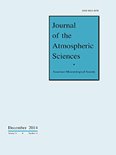
JOURNAL OF THE ATMOSPHERIC SCIENCES
Elevating the Standards of Meteorological ResearchJOURNAL OF THE ATMOSPHERIC SCIENCES, published by the American Meteorological Society, stands as a premier resource for the latest research in atmospheric sciences. With an impressive impact factor and a Q1 ranking in the Atmospheric Science category for 2023, this journal is recognized for its rigorous peer-reviewed articles that contribute to the understanding and advancement of weather, climate, and dynamics of the atmosphere. Established in 1969, the journal has maintained high academic standards and delivers valuable insights spanning over five decades, thus catering to an audience of researchers, professionals, and students alike. Although it does not offer open-access options, it provides critical access through various institutional subscriptions, ensuring that significant research findings are disseminated widely within the scientific community. The journal's address is located at 45 Beacon St, Boston, MA 02108-3693, United States, and it accepts submissions and articles until 2024, continuing its legacy of excellence in atmospheric research.
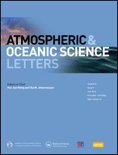
Atmospheric and Oceanic Science Letters
Unlocking the Secrets of Our Planet's SystemsAtmospheric and Oceanic Science Letters is a premier open-access journal dedicated to the rapidly evolving fields of atmospheric science and oceanography. Published by KEAI PUBLISHING LTD, this journal aims to foster research dissemination and collaboration by providing a platform for high-quality research articles, reviews, and case studies that address critical issues impacting atmospheric and oceanic systems. With an impressive impact factor reflecting its esteemed position—including being ranked Q2 in Atmospheric Science and Q1 in Oceanography in 2023—this journal is an essential resource for researchers, professionals, and students alike. The journal's Open Access model, adopted since 2016, ensures that groundbreaking research is readily available to a global audience, enhancing knowledge transfer and facilitating innovative solutions to environmental challenges. Operating out of the United Kingdom and reaching an international readership, Atmospheric and Oceanic Science Letters plays a pivotal role in shaping our understanding of the interactions between the atmosphere and oceans, making it a vital publication for anyone aiming to stay at the forefront of these dynamic scientific fields.

Atmosphere is a premier open-access journal dedicated to the field of atmospheric sciences, published by MDPI since 2010. With an E-ISSN of 2073-4433, the journal has established itself as a significant platform for the dissemination of research on atmospheric processes, climate change, and environmental dynamics. Based in Switzerland, the journal has garnered impressive recognition within the academic community, currently ranked in the 3rd quartile for Atmospheric Science and the 2nd quartile for Environmental Science (miscellaneous) as of 2023. Notably, it holds a commendable Scopus rank, emphasizing its impact with a 69th percentile standing in its category. Atmosphere aims to foster innovative research and comprehensive reviews that contribute to the understanding of air quality, climate policy, and environmental sustainability. Its open-access model not only supports the global sharing of knowledge but also enhances visibility and engagement among researchers, professionals, and students alike, making it an essential resource for anyone invested in the study of our planet's atmosphere.
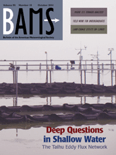
BULLETIN OF THE AMERICAN METEOROLOGICAL SOCIETY
Pioneering research that shapes our understanding of the skies.BULLETIN OF THE AMERICAN METEOROLOGICAL SOCIETY, published by the American Meteorological Society, stands as a premier forum in the field of meteorology and atmospheric science, boasting an impressive ranking in the Q1 category for 2023. With a long-standing history dating back to 1972, this journal serves as a vital resource for researchers, practitioners, and students dedicated to advancing the understanding of atmospheric phenomena. The journal facilitates the dissemination of cutting-edge research, innovative methodologies, and significant findings that propel the scientific community forward. Although not an Open Access journal, it remains a critical publication for comprehending complex environmental interactions, climate change, and weather-related phenomena. The BULLETIN OF THE AMERICAN METEOROLOGICAL SOCIETY is essential reading for anyone invested in atmospheric sciences, providing invaluable insights that shape policy, enhance safety, and promote environmental sustainability.

Journal of Meteorological Research
Your Gateway to Cutting-Edge Meteorological Insights.The Journal of Meteorological Research, published by SPRINGER HEIDELBERG, stands as a vital resource in the fields of Atmospheric Science and Ocean Engineering, boasting an impressive impact factor that reflects its scholarly significance. With its ISSN 2095-6037 and E-ISSN 2198-0934, the journal offers an open access platform, fostering accessibility and dissemination of cutting-edge research. Established in 2014 and running through to 2024, it is particularly distinguished in 2023 as Q2 in Atmospheric Science and Q1 in Ocean Engineering, underscoring its important contributions to these disciplines, with remarkable rankings in Scopus that place it in the top tiers of both categories. The journal accepts a broad range of research articles, reviews, and innovative methodologies, catering to a diverse audience of researchers, professionals, and students eager to advance their knowledge and expertise in meteorological studies. This makes the Journal of Meteorological Research an essential platform for anyone engaged in understanding and addressing the complex challenges of our changing climate.
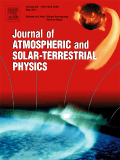
JOURNAL OF ATMOSPHERIC AND SOLAR-TERRESTRIAL PHYSICS
Exploring the Dynamics of Our Atmosphere and BeyondJournal of Atmospheric and Solar-Terrestrial Physics, published by Pergamon-Elsevier Science Ltd, stands as a pivotal academic resource in the realms of Atmospheric Science, Geophysics, and Space and Planetary Science. With an ISSN of 1364-6826 and an E-ISSN of 1879-1824, this journal encompasses a robust collection of research findings and reviews that address the intricacies of atmospheric processes and solar-terrestrial interactions. The journal has shown consistent academic performance, earning commendable rankings in 2023, including Q3 in Atmospheric Science and Q2 in Geophysics, reflecting its importance for scholarly communication and advancement in these fields. Spanning an impressive convergence of research from 1997 to 2024, it aims to foster interdisciplinary collaboration and inspire innovations among researchers, professionals, and students. Although it currently does not offer open access, the journal is committed to disseminating high-quality content that continues to drive forward our understanding of complex environmental phenomena.
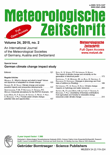
METEOROLOGISCHE ZEITSCHRIFT
Illuminating the Science of Weather PatternsMETEOROLOGISCHE ZEITSCHRIFT is a distinguished academic journal dedicated to the field of meteorology and atmospheric sciences, published by E SCHWEIZERBARTSCHE VERLAGSBUCHHANDLUNG. With an ISSN of 0941-2948 and an E-ISSN of 1610-1227, this journal has been an invaluable resource for researchers, professionals, and students since its inception. It has embraced an Open Access model since 2014, promoting wider dissemination of research findings. Based in Stuttgart, Germany, the journal is recognized for its rigorous peer-review process and is currently positioned in the Q3 quartile for Atmospheric Science as per the 2023 category rankings. Additionally, it ranks #97 out of 148 in the Scopus database, placing it in the 34th percentile among Earth and Planetary Sciences. Covering a broad spectrum of topics relevant to meteorology, METEOROLOGISCHE ZEITSCHRIFT serves as a platform for innovative research and theoretical contributions, aiming to advance understanding of atmospheric phenomena and their implications for climate and weather. Researchers and practitioners alike will find valuable insights within its pages, making it a significant asset in the landscape of meteorological scholarship.

Journal of Tropical Meteorology
Connecting Scholars to Unravel Tropical Meteorological MysteriesJournal of Tropical Meteorology, published by JOURNAL OF TROPICAL METEOROLOGICAL PRESS, is a leading scholarly journal dedicated to advancing the understanding of atmospheric phenomena and meteorological patterns in tropical regions. With an ISSN of 1006-8775, this journal plays a vital role in disseminating high-quality research, focusing on critical issues such as climate variability, weather forecasting, and tropical cyclone dynamics. The journal, which is indexed in Scopus with a respectable rank in the low quartile of Q3 in Atmospheric Science, aims to provide a platform for researchers and professionals to share groundbreaking insights and foster collaboration within the scientific community. Although it follows a traditional access model, the Journal of Tropical Meteorology encourages submissions from a diverse range of disciplines, thus enriching the field with a variety of perspectives. By bridging theory and practical applications, this journal serves as an essential resource for students, researchers, and practitioners striving to expand their knowledge and contribute to the global conversation on meteorology.

METEOROLOGY AND ATMOSPHERIC PHYSICS
Unveiling the Secrets of Our AtmosphereMETEOROLOGY AND ATMOSPHERIC PHYSICS is a premier journal published by SPRINGER WIEN, dedicated to advancing the study of atmospheric phenomena and weather-related sciences. With an ISSN of 0177-7971 and an E-ISSN of 1436-5065, the journal has established itself as an important contributor in the field, particularly noted for its contributions in atmospheric science, holding a Q3 ranking in the 2023 category quartiles. Covering a wide array of topics from meteorological modeling to the physics of the atmosphere, it serves researchers, professionals, and students alike, facilitating the dissemination of significant findings and innovative research. The journal’s acceptance of articles until 2024 encourages a continuous influx of knowledge, and despite its lack of Open Access, it plays a crucial role in enriching the academic landscape for those engaged in Earth and planetary sciences, holding a commendable rank of 78 out of 148 in Scopus. Located in the scenic city of Vienna, Austria, the journal is positioned to harness the vibrancy of the academic community, providing a platform for valuable insights that can drive forward the field of meteorology and atmospheric physics.

JOURNAL OF THE METEOROLOGICAL SOCIETY OF JAPAN
Pioneering Research in Climate and WeatherJournal of the Meteorological Society of Japan, ISSN 0026-1165 (E-ISSN 2186-9057), is a leading academic journal published by the Meteorological Society of Japan, dedicated to advancing the field of atmospheric sciences. Established in 1905, the journal has a long-standing tradition of publishing high-quality research that contributes to our understanding of meteorology, climatology, and environmental science. As an Open Access journal since 2018, it ensures wide dissemination of knowledge, allowing researchers, professionals, and students to access cutting-edge studies without barriers. With an impressive impact factor and ranked in the Q1 category in Atmospheric Science, it is recognized for its significant contributions, currently holding a Scopus rank of #36 out of 148 in the field. The journal serves as a vital resource for those involved in meteorological research, policy-making, and education, fostering collaboration and innovation within and beyond Japan.